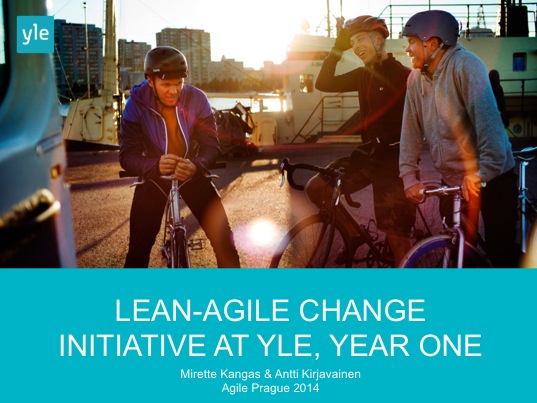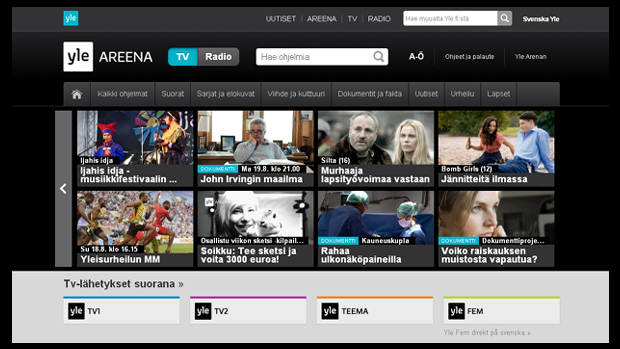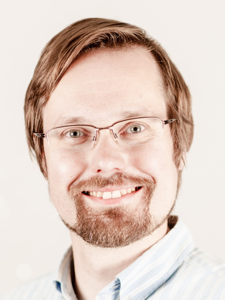Two weeks ago, I presented the talk “The lean-agile change initiative at Yle, year one” with Yle’s head of development Mirette Kangas 1 at the Agile Prague 2014 Conference. We found out that the process of preparing our talk was actually a process of further reflection upon what really happened last year and what could we learn about it. That is why I’m writing a series of posts to highlight our most important findings.
In this first post I will highlight the importance of the way that you go about planning and implementing the change initiative. In many cases agile transformations are still run as projects. I think that lowers their chances of succeeding significantly.
Do change work in lean and agile way
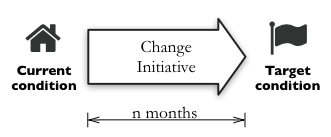
Treating change initiative as a linear project may hurt the chances of success of the change.
People need a concrete example of how their ways of working might look and feel like after the change. This means that treating the change initiative as a linear project does not help. Instead, treat it the same way you would treat product development: create a strong vision together with all the stakeholders and then work closer towards that vision step by step, iteratively and incrementally, inspecting and adapting to find the most effective ways to proceed.
At Yle, we started with the Areena development organisation. They had practical problems for which they wanted practical solutions:
- How to do portfolio level decision-making, planning and tracking effectively
- How to arrange work in a development organisation with over 20 people, with both new development and maintenance work
- How to foster collaboration in the development organisation
What is Areena, you may ask. Let me give a short overview: it is the online video-on-demand service of Yle. It is available on web and for the most used mobile platforms: iPhone, iPad, Android and Windows Phone. Practically all of Yle’s television and radio programmes are available on Areena. Areena is Finland’s most appreciated online brand.
However, when we progressed with other areas of the change initiative, it became apparent that these practical problems faced by the different development organisations were manifestations of more systemic conditions inside the organisation. To improve, we had to think about changing bigger things.
Set the Vision for Change
To consider a more holistic approach for the change initiative we had to facilitate the discussion of what was needed and what was important inside the organisation. All levels of management, including the directors, were involved as well as the experts who worked with solutions every day. We facilitated them to come up with organisation-wide goals for both the customer impact and for the target condition of ways of working.
After those were established, our change work became simpler. We could work in the different parts of organisation and together with the people there, identify improvement opportunities related to the shared goals and work iteratively to make them reality.
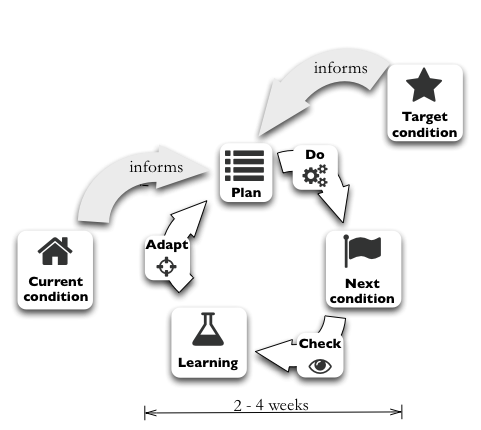
Whe found out that an iterative and incremental approach to change improved our chances of succeeding.
Provide Transparency
After facilitating the setting of vision for change, we started to focus on our communication. We wanted to achieve same kind of transparency that a lean-agile product development effort would have. That is why we kept the vision statement and the backlog of focus areas and actions in Confluence wiki where anyone in the organisation could pull the information on what we were doing and how we were progressing.
In addition to that, we organised regular demos on our change initiative. We invited all the stakeholders and provided them with demonstrations of recent accomplishments in our initiative. We encouraged people from different parts of organisation to perform the demos so that they would feel more ownership of the change work, too.
Facilitate everyone’s participation
Third principle we found useful in change work is to shift the focus from ourselves to the people in the organisation. To create ownership for the change, we needed to involve the people.
That started from involving all the stakeholders to create the vision and continued with inviting all the people in the workshops to make the important decisions and also to generate options for improvement.
Demos were another important step for making more people inside the organisation active participants. By giving them the chance to demonstrate the results and changes we achieved together made them more committed on making the changes stick and to do even more improvement work. We also used the demos to make decisions on the new principles and practices we came up with to ensure commitment to them.
Conclusion
We found out that the change work becomes more effective if we work according to couple of principles that we adapted from lean-agile thinking: setting a shared vision, providing transparency and facilitating everyone’s participation in the collaborative change work.
With these, we achieved a couple of positive effects:
- We were able to convey how the lean-agile way of working feels in practice.
- Stakeholders committed to the shared vision of the change initiative.
- People took ownership of the change work.
- People were proud when they made progress in the change work.
- People were more committed to work collaboratively.
In the next installments of this series I will discuss the importance of communication and how individuals and interactions are the key ingredients for organziational change.
If you want to know more about the approach I have used at Yle and other organisations to facilitate organisational change and improvement to better serve the goals of the organisation, please drop me an email or a tweet.
If you want to stay updated on the later posts describing the lean-agile change initiative at Yle along with other articles, please subscribe to our newsletter.
Footnotes
-
Mirette Kangas is an incredible person I have had the pleasure for working with for over a year now. She is the head of development at Yle, focusing on the changing media market and lean and agile. She was the main change agent behind the introduction of lean-agile change at Yle. While her background is that of a Master of Arts, she has been in the forefront in the development of internet services at Yle for many years. Before that she has managed a huge number of software service and product development projects during her career. ↩
